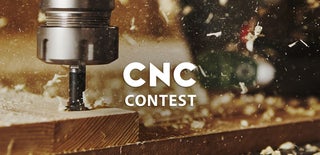Introduction: YES! You Can CNC Mill Metal! Eleksmill $200 Machine
I recently built a 20 ton press for using impression dies to create designs in copper plate. It started with a die that I bought from https://www.potterusa.com/impression-die-landis-b... These are extremely cool, but they aren't cheap. I wanted to see if I could make one myself which would open a whole world of possibilities.
I decided that i would try to start with an impression die of a shiba inu (a little dog that we have running around our house).
Step 1: Getting the Model Ready for CNC
To get the project started, I found an STL file on thingiverse: https://www.thingiverse.com/thing:1308678 built by Layerone. I imported the STL into fusion 360.
Because I only needed half of the dog to create the impression, I created a cylinder around the whole object (photo) with a height equal to half the dogs body. When I joined the two I basically had the positive side of the die.
The next step was to create the negative.
I exported the combined dog/cylinder as an STL, and imported it into Tinkercad. The awesome thing about Tinkercad is that you can use an object to cut something else by making it "invisible" and combining them.
Import the stl into tinkercad, and create another cylinder the same size so the dog is completely encased in the two cylinders. (photo 2) Select the imported object (to be molded) and turn that into a "hole"
When they are aligned and together, you hit the combine button and they fuse together, creating the negative side. (photo 3) Export the final object as an STL and import it back into fusion 360. It will come in as a mesh adn will be pink.
Now you have your model (photo 4), time to get to the machining part.
Step 2: Setting Up the Machining Tool Path
The first photo shows the imported negative die as a mesh file.
I sized the model to about the size of the stock I had out in the garage. 40mm aluminum round bar stock.
When it was the correct size, i clicked over to the manufacture tab in the upper left. When you manufacture, you need to perform a setup: The stock size, the machine, and the tool size that you will be using. Nothing fancy, just the minimum is provided in picture 2 and 3.
That gets the machine set up, now it was time to set the tool path. I chose parallel tool setup with the details for each of the tabs. If you do the bare minimum, and then generate a toolpath, you will see what it will look like. The final photo.
Step 3: Generate the Code
There are a bunch of g code sending tools, the easiest one that I have found to use is Inventables Easel. Easel will allow you to plug in your CNC machine via USB and send the data. In order to get it to Easel, you need to do a post process in Fusion 360, photo 1. Save it to a folder on your computer.
Open Easel, locate the downloaded file and import it. When it is imported it will drop it onto the 0 -0 axis on the plane. If you zoom in, you will see the same toolpath pattern that was in Fusion.
Step 4: Mill!
The tools in photo 1 are the ones that came with the Eleksmill. They are engraving bits, but when I tried it, they will cut plastic, aluminum, and brass!
Photo 2 is the eleksmill (with a modification, but not required to do the milling discussed).
The video shows the cutting process.
Note: To attach the stock to the table: i put masking tape on the table, and and masking tape on the bottom of the stock. Then put super glue between the two pieces of masking tape. It works very well, and holds the material well.
Good luck, let me know if you have questions. There are also a TON of videos on youtube for using all the software tools.
Attachments

Participated in the
CNC Contest 2020














